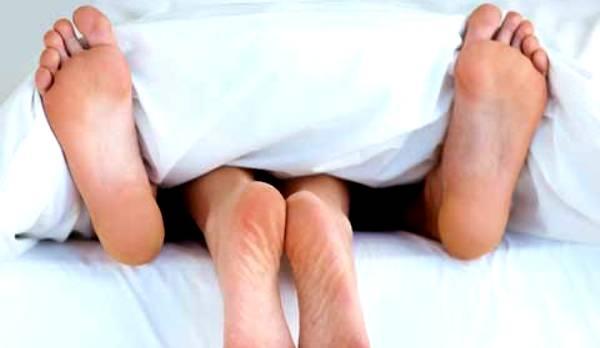Hormones Sway Women's Sex Lives - Kind Of

Hormones may nudge women toward having more sex during fertile periods, but practical concerns such as work and a partner's desire may ultimately matter more for how often women get busy.
Those are the findings of a new study on the murky relationship between hormones and female sexuality. The research is the first to compare partnered women with singled women while also measuring fertility directly. It also boasted an impressive number of participants: 1,957, all of whom underwent repeated ultrasounds to pinpoint exactly when they ovulated during the study.
Previous research on sexuality and the menstrual cycle used less accurate methods, such as counting the days since the last period, to guess at ovulation, leading to questionable conclusions, said study researcher Salvatore Caruso of the University of Catania in Italy
"They were not well made," Caruso told LiveScience of those earlier attempts.
Sexual confusion
Many mammals go into heat when they're fertile, signaling their sexual interest. A female horse, for example, will pee hormone-rich streams of urine. The scent clues stallions in that she's ready to mate. Baboon females show off red behinds — the bigger, the better, as far as males are concerned.
Outside of these phases, these mammals aren't interested in sex. Humans are different. Women's ovulation is hidden (though they may give off accidental cues in the way they move and dress), and women have sex all month long, regardless of whether they've recently ovulated. [10 Odd Facts About the Female Body]
Sign up for the Live Science daily newsletter now
Get the world’s most fascinating discoveries delivered straight to your inbox.
Still, research has been mixed on whether any mammalian hormonal impulses influence human sexuality. Some studies have shown that women's sexual activity is consistent across the entire menstrual cycle. Others have revealed possible correlations between hormone levels or ovulation and sexual interest.
But the picture wasn't clear, in part because ovulation is so secretive. Accurately measuring when the women in a study are ovulating tends to be time-consuming and expensive, meaning most researchers have been forced to use estimates.
Caruso and his colleagues made the extra effort. Between 2004 and 2011, they recruited 1,957 heterosexual women, excluding those using hormonal birth control. About three-quarters of the women were in long-term relationships (longer than six months). The rest were single or casually dating.
The women, who ranged in age between 18 and 40, shared their sexual histories and agreed to keep a daily diary of all sexual activity and arousal for a month. During that month, they had three transvaginal ultrasounds of their ovaries. Before ovulation, an unfertilized egg develops in a follicle, visible as a tiny bump on the outside of the ovary. The ultrasounds pinpointed this follicle and recorded the day that it burst, releasing the egg, a process known as ovulation.
The researchers also tested the women's blood pre-ovulation, around ovulation and post-ovulation to measure hormone levels.
Hormones and sex
The researchers found that women in relationships engaged in sexual activity (including masturbation) 1.9 times a week, on average, while single women got frisky 1.5 times a week. Women with partners were more likely to have sex on the weekends, highlighting the importance of daily routine in sexuality — there's just more time to spend in bed on Saturdays and Sundays. [Sexy Tech: 6 Apps That May Stimulate Your Love Life]
"Probably the couple is affected by psychosocial factors more than the single woman, for example, family management and leisure of both the woman and the partners," Caruso said.
But hormones and the menstrual cycle seemed to play a small roll. Sexual activity increased along with masculine hormones in the bloodstream of which testosterone is the most famous. Testosterone is typically elevated around ovulation, though it can vary widely from woman to woman and across the menstrual cycle.
Single women, in particular, had more sex around the time they ovulated. That finding suggests singles might be relatively more influenced by biology compared with coupled women, who have to contend with their partners' needs and family responsibilities, Caruso said.
"Ovarian steroids are not able to modulate a woman's sexual activity, but could increase the probability that sexual activity will occur more often when they are fertile than when they are not," he said, referring to sex hormones like testosterone and estrogen.
Previous research had found that testosterone increases women's interest in masturbation, but not necessarily partnered sex.
Caruso and his colleagues are now expanding their study to women using hormonal birth control, post-menopausal women and women with hormone disorders. The goal, he said, is to tease out how much hormones matter to a woman's sexuality — and to what extent culture can override the biological influences.
The researchers published their findings Oct. 30 online in the Journal of Sexual Medicine.
Follow Stephanie Pappas on Twitter and Google+. Follow us @livescience, Facebook & Google+. Original article on LiveScience.

Stephanie Pappas is a contributing writer for Live Science, covering topics ranging from geoscience to archaeology to the human brain and behavior. She was previously a senior writer for Live Science but is now a freelancer based in Denver, Colorado, and regularly contributes to Scientific American and The Monitor, the monthly magazine of the American Psychological Association. Stephanie received a bachelor's degree in psychology from the University of South Carolina and a graduate certificate in science communication from the University of California, Santa Cruz.









